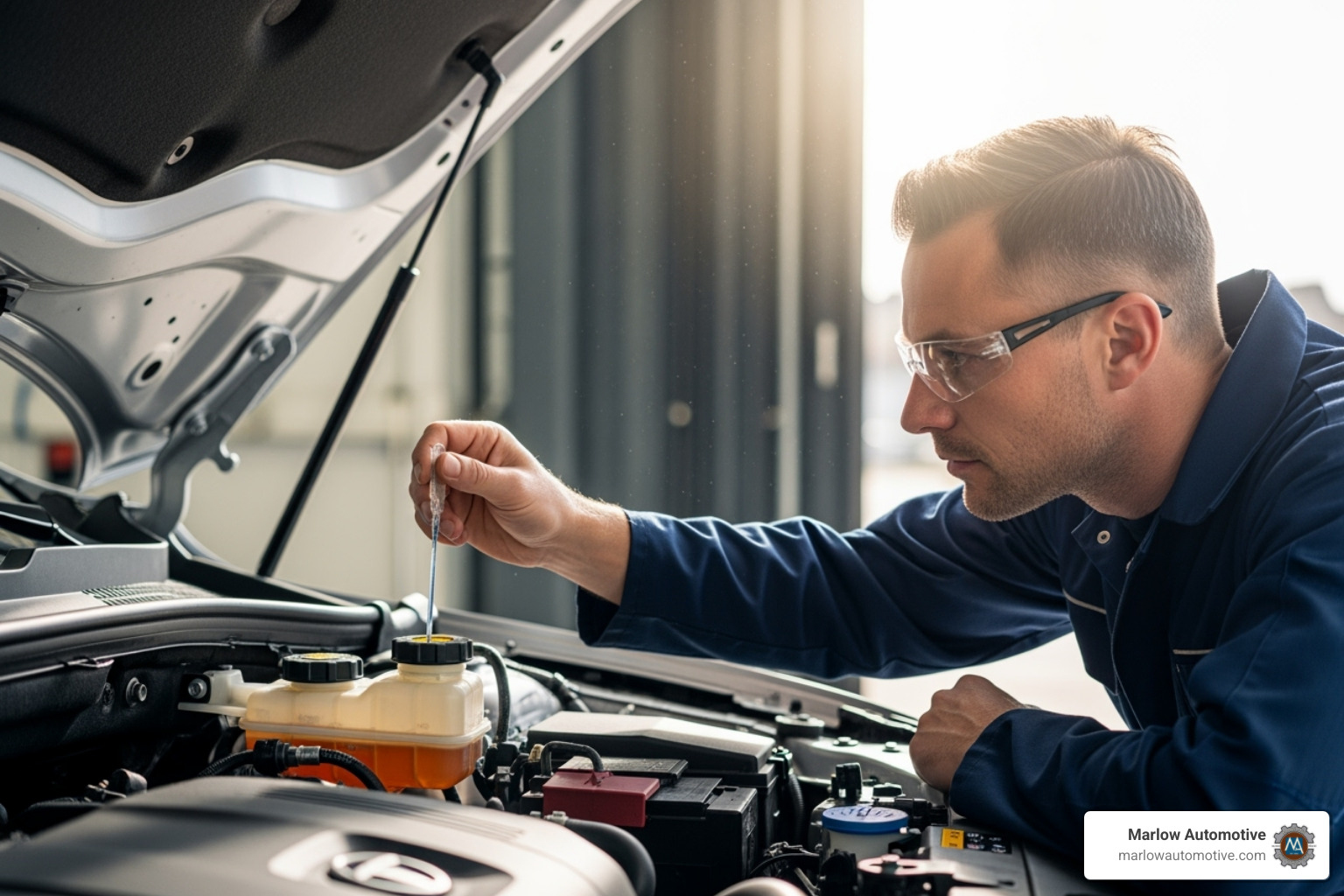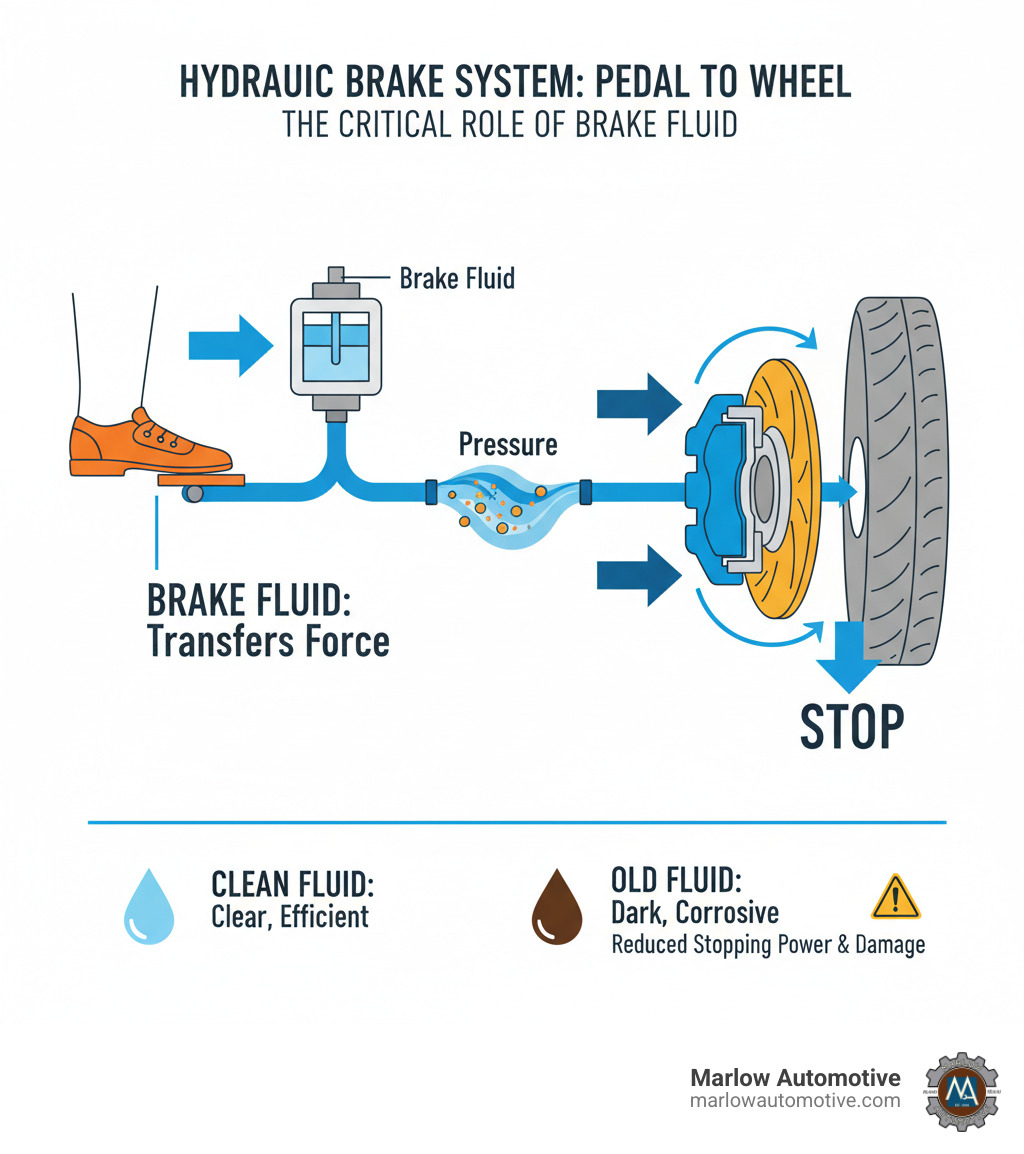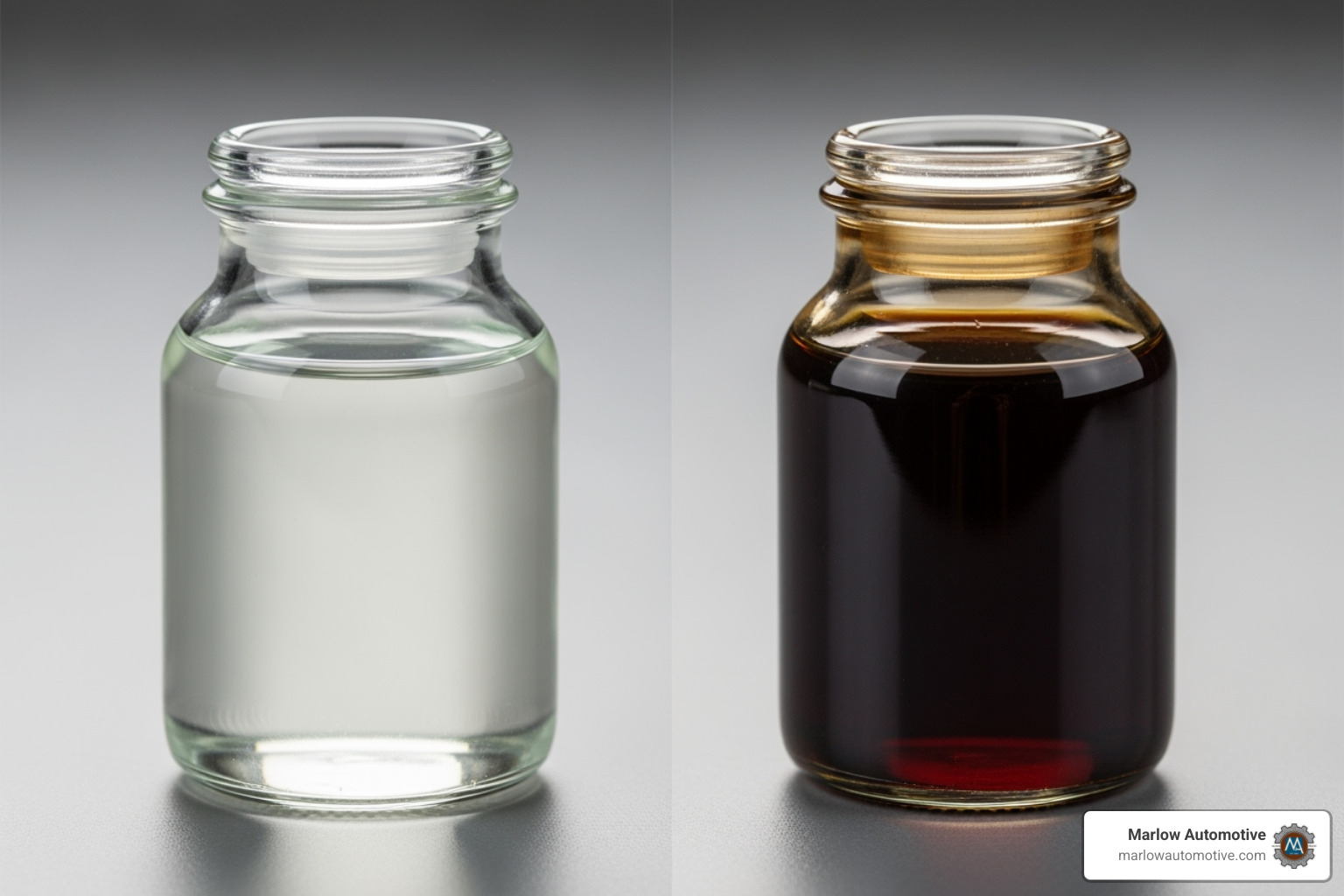Demystifying the Brake Fluid Flush: A Complete Guide

Why Your Vehicle's Braking System Depends on Clean Brake Fluid
A brake fluid flush is a maintenance service that completely replaces old, contaminated brake fluid with fresh fluid to ensure optimal braking performance and prevent system damage.
Quick Answer: What You Need to Know About Brake Fluid Flushes
- What it is: Complete replacement of old brake fluid with new fluid
- Why it's needed: Brake fluid absorbs moisture over time, causing corrosion and reduced braking power
- How often: Every 2-3 years or 40,000-45,000 miles
- Average cost: $173 to $205
- Service time: Under 1 hour at a professional shop
- Warning signs: Spongy brake pedal, dark fluid color, reduced stopping power
When you press your brake pedal, you're relying on a hydraulic system that uses brake fluid to transfer force from your foot to your wheels. This seemingly simple process involves brake fluid that can reach temperatures close to 550 degrees during extreme braking conditions.
But here's what many Plano drivers don't realize: brake fluid is hygroscopic, meaning it absorbs water from the air at a rapid rate. As one automotive expert puts it, "Brake fluid is arguably the most ignored fluid change on your car" - yet it's critical for your safety.
Over time, this moisture contamination turns your clear brake fluid into a dark, corrosive liquid that can damage expensive brake components and compromise your vehicle's stopping power. The result? Potential brake fade, internal corrosion, and costly repairs that could have been prevented with regular maintenance.

What is Brake Fluid and Why Does It Go Bad?
Your car's braking system is essentially a hydraulic marvel that happens thousands of times during your daily drive. When you press the brake pedal, you're not directly stopping your car - you're actually pushing brake fluid through a network of lines and hoses that carry that force to each wheel.
Think of brake fluid as the messenger in this life-saving conversation between your foot and your wheels. This specialized hydraulic fluid needs to be non-compressible so every bit of pressure you apply gets delivered instantly. It also needs an incredibly high boiling point - we're talking around 400-500°F - because braking generates serious heat.
But brake fluid doesn't just carry messages. It's also working as a lubricant for all those moving parts in your brake calipers and wheel cylinders. Plus, it contains corrosion inhibitors that protect the metal components from rust and wear. It's basically a multi-tasking superhero fluid.
The Problem with Old Brake Fluid
Here's where things get interesting (and not in a good way). Brake fluid is a glycol-ether based hydraulic fluid that has one major weakness: it's hygroscopic. That's a fancy way of saying it soaks up water like a sponge soaks up spilled coffee.
Even though your brake system is sealed, tiny amounts of moisture sneak in through brake hoses and seals over time. This might not sound like a big deal, but water is brake fluid's worst enemy.
When water contaminates your brake fluid, the boiling point drops dramatically. Remember how we said brake fluid needs to handle 400-500°F? Well, water boils at just 212°F. When you brake hard and that contaminated fluid gets hot, it creates vapor bubbles in your brake lines.
Those bubbles are compressible - unlike pure brake fluid. So when you press the pedal, instead of stopping your car, you're just squishing bubbles. This creates that terrifying spongy brake pedal feel and serious brake fade. Your pedal might even go all the way to the floor.
But wait, there's more bad news. That water also causes internal corrosion throughout your brake system. Your brake calipers, wheel cylinders, and even your expensive ABS module can all suffer damage. We've seen this at Marlow Automotive - corroded brake components that could have been prevented with a simple brake fluid flush.
The really frustrating part? This damage often leads to costly brake repairs that cost far more than regular maintenance. It's like skipping oil changes and then wondering why your engine seized up.
The bottom line is simple: old, contaminated brake fluid isn't just ineffective - it's actively damaging your brake system while putting your safety at risk.
When to Service Your Brakes: Key Signs and Recommended Intervals
Your car has a way of communicating with you when something needs attention, and your braking system is no exception. Learning to recognize these signals can mean the difference between a simple brake fluid flush and a much more expensive repair bill.
The most telling sign that your brake fluid needs attention is a spongy or soft brake pedal. If you've been driving your car for a while, you know how your brakes normally feel. When that pedal starts feeling mushy or travels closer to the floor than usual, it's your car's way of telling you there's trouble brewing. This happens because contaminated brake fluid with absorbed moisture can create vapor bubbles when heated, making your pedal feel like you're stepping on a sponge instead of activating a precision hydraulic system.
You might also notice that your car just doesn't stop like it used to. Maybe you're pressing the brake pedal harder to get the same response, or it takes a bit more distance to come to a complete stop. This reduced stopping power is a clear red flag that your brake fluid isn't doing its job effectively anymore.
Here's something you can check yourself: pop the hood and take a look at your brake fluid reservoir (it's usually a small, clear plastic container near the back of the engine bay). Fresh brake fluid looks clear or slightly yellowish, almost like honey. If you peer into that reservoir and see dark brown or black fluid staring back at you, that's contaminated brake fluid crying out for replacement.
Sometimes your dashboard will join the conversation too. A brake warning light or ABS light can indicate various brake system issues, including problems with old, contaminated fluid. While these lights don't always point directly to brake fluid, they're worth investigating - especially if you're experiencing any of the other symptoms we've mentioned.

How Often Should You Get a Brake Fluid Flush?
Unlike some maintenance services that can vary widely between vehicles, brake fluid replacement follows fairly consistent guidelines. Your owner's manual should be your first stop for manufacturer-specific recommendations, but most automotive experts agree on some general principles.
Time is more important than mileage when it comes to brake fluid. Because brake fluid absorbs moisture from the air regardless of how much you drive, most professionals recommend a brake fluid flush every two to three years. Some mechanics suggest annual replacement if you notice the fluid looking dark or contaminated.
From a mileage perspective, the sweet spot seems to be every 40,000 to 45,000 miles. This interval accounts for normal driving conditions and the inevitable moisture absorption that occurs over time.
Your driving environment can influence these intervals too. If you live in a particularly humid climate like we have here in Texas, or if you frequently tackle mountainous terrain that demands heavy braking, you might want to lean toward the more frequent end of that range.
The beauty of regular brake fluid maintenance is that it's a small investment that pays big dividends. It's a cornerstone of proper routine auto maintenance that can save you from the headache and expense of major brake system repairs down the road. Think of it as insurance for one of your car's most critical safety systems.
The Complete Brake Fluid Flush Process
A brake fluid flush isn't your typical weekend DIY project. It's a precise procedure that requires specialized equipment and expertise – especially when your family's safety depends on the outcome. Think of it like surgery for your brakes: you want someone with the right tools and training handling the operation.
At Marlow Automotive, our certified technicians approach every brake fluid flush with the care it deserves. We use professional-grade equipment to completely remove every drop of old, contaminated fluid from your master cylinder, brake lines, calipers, and wheel cylinders. Then we replace it with fresh, manufacturer-approved brake fluid that meets your vehicle's exact specifications.
This isn't a quick top-off job. A proper flush means systematically pushing new fluid through your entire braking system until we're confident that all moisture and contaminants are gone. It's thorough work that restores your braking system to like-new performance – the kind of comprehensive service that gives you confidence when you need to stop quickly.
Our comprehensive brake service approach ensures that every component in your braking system gets the attention it needs for optimal safety and performance.
Brake Fluid Flush vs. Brake Bleed: What's the Difference?
Here's where things get a bit technical, but it's worth understanding the difference. Many people use these terms interchangeably, but they're actually quite different procedures.
A brake bleed is like putting a bandage on a cut. It's designed to remove air bubbles from a specific part of your brake system, usually after we've replaced a component or opened a brake line. We push a small amount of fluid through to expel the air and restore proper pedal feel. It's a targeted fix for a specific problem.
A brake fluid flush, on the other hand, is like giving your entire brake system a complete blood transfusion. We systematically replace all the old fluid throughout the entire system – from the master cylinder to each wheel. This removes not just air, but also the accumulated moisture, corrosion particles, and other nasties that have built up over time.
Think of it this way: bleeding fixes an immediate problem, while flushing prevents future ones. A brake bleed might get you back on the road today, but a brake fluid flush keeps you safe for years to come.
DIY vs. Professional Service: Making the Right Choice
We get it – there's something appealing about rolling up your sleeves and tackling car maintenance yourself. But when it comes to brake work, we're going to be straight with you: this isn't the place to learn on the job.
You can attempt a DIY brake fluid flush. You'll need specific tools like a fluid extractor, bleeder kit, and the right type of brake fluid. But here's the thing – you'll also need to know the correct bleeding sequence for your specific vehicle, understand how to avoid introducing air into the system, and be prepared to spend most of your weekend figuring it out.

The safety risks are real. Any mistake during a brake fluid flush can leave you with spongy brakes or, worse, brake failure. That's not a gamble worth taking when you're merging onto Central Expressway during rush hour.
Then there's the disposal issue. Used brake fluid is hazardous waste that needs to be handled properly. You'll need to properly dispose of used brake fluid at a facility near you, which adds another step to your already complex weekend project.
Modern vehicles make DIY flushes even trickier. If your car has ABS or electronic stability control (and most do these days), you might need specialized scan tools to activate certain valves during the flush. Without these tools, you could miss contaminated fluid in hard-to-reach areas or even damage expensive components.
Here's why professional service makes sense: expertise, proper equipment, and peace of mind. Our technicians know your vehicle's specific requirements and have the pressure bleeders, vacuum pumps, and diagnostic tools needed for a complete job. We use high-quality fluid that meets your manufacturer's specs, and we can get it done in under an hour while you relax in our waiting area.
Most importantly, when you drive away from Marlow Automotive after a brake fluid flush, you can trust that your brakes will work exactly as they should when you need them most. That confidence is worth every penny.
Understanding Brake Fluid Types and Costs
When it comes to brake fluid, one size definitely doesn't fit all. The U.S. Department of Transportation has created specific standards (those DOT ratings you see on bottles) that classify brake fluids based on their boiling points and what they're made of. Think of it like choosing the right grade of motor oil – using the wrong type isn't just ineffective, it can actually damage your braking system.
DOT Ratings: What You Need to Know
Here's where things get interesting. Most brake fluids fall into the glycol-ether family, which means they're hygroscopic (remember that word from earlier?). But there's one rebel in the group that's completely different.
DOT 3 is your basic, reliable brake fluid. It's glycol-ether based and does the job for many everyday vehicles, especially older ones. While it has lower boiling points than its cousins, it's perfectly adequate for normal driving conditions.
DOT 4 steps things up a notch. Also glycol-ether based, it can handle higher temperatures before boiling, making it the go-to choice for most modern cars, trucks, and anything with a bit more performance under the hood. The good news? DOT 4 is usually backward compatible with DOT 3 systems, though you should always double-check your owner's manual first.
Now here's where people get confused: DOT 5 is the odd one out. It's silicone-based, not glycol-ether, which means it doesn't absorb water like the others. Sounds great, right? Well, there's a catch – it can trap air bubbles, giving you that spongy pedal feel nobody wants. More importantly, DOT 5 is absolutely not compatible with DOT 3, DOT 4, or DOT 5.1 systems. Mix them, and you're looking at damaged seals and potentially catastrophic brake failure. DOT 5 is mainly used in military vehicles and some custom applications where water absorption is a bigger concern than air bubbles.
DOT 5.1 brings us back to the glycol-ether family, but with impressive high-temperature performance that rivals DOT 5 without the compatibility headaches. It's designed for high-performance applications and works well with systems designed for DOT 3 or DOT 4.
The bottom line? Always check your owner's manual for the correct DOT rating. As one expert puts it, "Using the wrong type of brake fluid can cause damage to your braking system" – and that's not something you want to learn the hard way.
| Type | Base | Dry Boiling Point (min) | Wet Boiling Point (min) | Compatibility with DOT 3/4 | Notes |
|---|---|---|---|---|---|
| DOT 3 | Glycol-ether | 401°F (205°C) | 284°F (140°C) | Yes | Common, hygroscopic. |
| DOT 4 | Glycol-ether | 446°F (230°C) | 311°F (155°C) | Yes | Higher performance than DOT 3, hygroscopic. |
| DOT 5 | Silicone | 500°F (260°C) | 356°F (180°C) | No | Not hygroscopic, can trap air, not for ABS, causes seal damage in glycol systems. |
| DOT 5.1 | Glycol-ether | 518°F (270°C) | 356°F (180°C) | Yes | High performance, hygroscopic, similar to DOT 4 but with higher boiling points. |
Understanding the Cost of a Brake Fluid Flush
Here's some good news: a brake fluid flush is one of the most affordable ways to protect your vehicle's safety and avoid expensive repairs down the road. The average cost typically runs between $173 and $205 – a small price to pay for peace of mind.
Several factors influence what you'll pay for this service. Labor rates make up the biggest chunk of the cost, and these vary by location. Here in Plano and the broader DFW area, we're proud to offer competitive pricing that delivers exceptional value.
Your vehicle type also plays a role. If you drive a luxury car or something with complex braking systems like advanced ABS or electronic parking brakes, the service might take a bit more time and specialized knowledge. Similarly, some vehicles require specific procedures or diagnostic tools that can affect the final price.
The type of brake fluid your car needs can also influence cost, though usually not dramatically. While DOT 3 and DOT 4 are typically priced similarly, high-performance DOT 5.1 or specialized European vehicle fluids might cost a bit more.
When you consider the alternative – potentially thousands of dollars in repairs for corroded calipers, a damaged master cylinder, or a failed ABS module – that $173 to $205 investment starts looking pretty smart. At Marlow Automotive, we believe in providing expert care that exceeds dealership quality, using the best parts and technicians, all backed by our 2/24 warranty.
Neglecting this simple maintenance can lead to corrosion and damage throughout your braking system, resulting in much more expensive repairs. A brake fluid flush isn't just maintenance – it's insurance for your safety and your wallet.
Frequently Asked Questions about Brake Fluid Service
We hear these questions all the time from our Plano customers, and honestly, they're great questions! Understanding your brake fluid service helps you make informed decisions about your vehicle's safety.
How long does a professional brake fluid flush take?
Here's some good news: a professional brake fluid flush won't eat up your entire day. Most of the time, we can get you in and out in under an hour. That includes everything - setting up our specialized equipment, completing the flush, and making sure your system is sealed up tight and working perfectly.
Now, some vehicles are a bit more complex than others. If you've got an intricate ABS system or electronic stability control, it might take a few extra minutes. But our team at Marlow Automotive has the experience and equipment to work efficiently while never cutting corners on quality.
The best part? You can often grab a coffee and be back on the road before you know it. No need to arrange a whole day around this essential maintenance.
Can I just top off my brake fluid instead of flushing it?
We get this question a lot, and we totally understand the thinking behind it. Unfortunately, topping off your brake fluid is not a substitute for a proper brake fluid flush. Here's why that approach won't solve the real problem:
When you just add new fluid to the reservoir, you're not addressing the contaminated, moisture-filled old fluid that's still circulating throughout your entire braking system. It's like adding fresh cream to spoiled milk - the whole mixture is still compromised.
There's another important point here: if your brake fluid is consistently low, that's usually telling you something. You might have a leak somewhere in the system, or your brake pads could be worn enough that the caliper pistons have extended further, pulling more fluid into the lines.
Simply adding more fluid without investigating why it's low in the first place is like putting a band-aid on a broken bone. If you're seeing warning lights along with low brake fluid, it might be worth getting a check engine light service to see if there are other issues that need attention.
The contamination from moisture and debris doesn't magically disappear when you add fresh fluid on top. A proper flush removes all that old, degraded fluid and replaces it with clean, fresh brake fluid throughout the entire system.
What happens if I use the wrong type of brake fluid?
This is where things can get really expensive, really fast. Using the wrong brake fluid isn't just a minor mistake - it can cause serious damage to your braking system and put your safety at risk.
The biggest problem is seal degradation. Your brake system has rubber seals and hoses that are designed to work with specific types of fluid. If you accidentally put silicone-based DOT 5 fluid into a system designed for glycol-based fluids like DOT 3 or DOT 4, those seals can swell up, get soft, or start to corrode. When that happens, you'll get leaks, lose pressure, and potentially face complete brake failure.
The reverse is just as bad. Put glycol-based fluid into a system designed for DOT 5, and you'll see corrosion and breakdown of the silicone components.
Either scenario can lead to brake failure - and that's not something you want to find when you're trying to stop at a red light. Beyond the safety concerns, you're looking at potentially expensive damage to calipers, master cylinders, and especially those delicate ABS components that can cost thousands to replace.
System damage from incompatible brake fluid can sometimes mean replacing major components rather than just fixing them. We've seen cases where the wrong fluid caused so much internal damage that it would have been cheaper to prevent the problem with regular maintenance.
Always check your owner's manual or ask us what type of brake fluid your vehicle needs. It's such a simple thing to verify, but getting it wrong can turn a routine maintenance item into a major repair bill.
Your Braking System's Lifeline
Throughout this guide, we've explored why a brake fluid flush is so much more than routine maintenance – it's truly your braking system's lifeline. Think about it: every time you press that brake pedal, you're trusting a hydraulic system that depends entirely on clean, uncontaminated fluid to keep you and your loved ones safe.
We've seen how brake fluid's hygroscopic nature means it's constantly absorbing moisture from the air, gradually turning from clear protection into a dark, corrosive threat to your brake components. We've discussed how this contamination leads to dangerous brake fade, expensive ABS module damage, and the kind of repair bills that make you wish you'd scheduled that simple flush.
The good news? You now know the warning signs to watch for – that spongy pedal feel, the dark fluid in your reservoir, or reduced stopping power. You understand that every 2-3 years or 40,000-45,000 miles, your brake system needs this vital refresh. And you've learned why professional service gives you the peace of mind that comes with specialized equipment, proper disposal, and expert knowledge of modern brake systems.
At Marlow Automotive, we've built our reputation on treating every brake fluid flush as the critical safety service it truly is. Our expert care exceeds dealership standards because we use only the best parts and employ certified technicians who understand that your family's safety is riding on their work. Our 2/24 warranty backs every service, and we believe in keeping you informed every step of the way.
Whether you're driving through Plano, commuting to Garland, or traveling anywhere across the DFW area, your brakes should never be a source of worry. Don't wait until that pedal feels soft or you notice dark, contaminated fluid. Prevention is always better – and cheaper – than repair.
Your vehicle's braking system deserves the same attention you give to other vital safety features. After all, you can fix almost anything on a car – except an accident that could have been prevented.
Ready to give your brakes the care they deserve? Schedule your brake fluid flush in Plano, TX with Marlow Automotive today. Let us help you drive with confidence, knowing your braking system is performing exactly as it should – flawlessly, safely, and reliably.

Customer Testimonials
Service Areas







